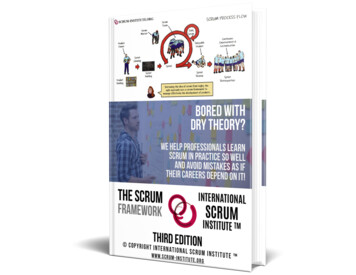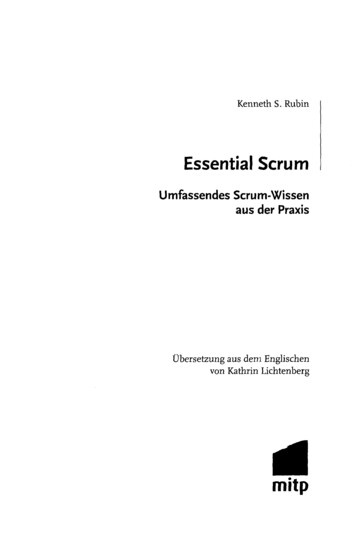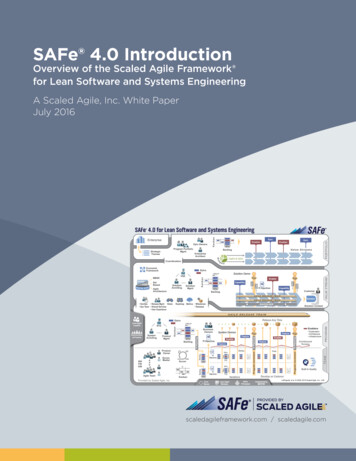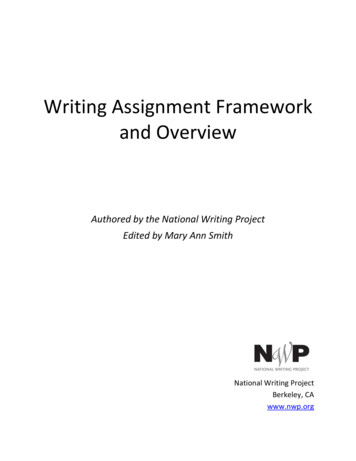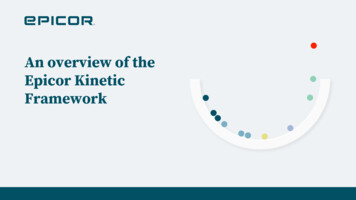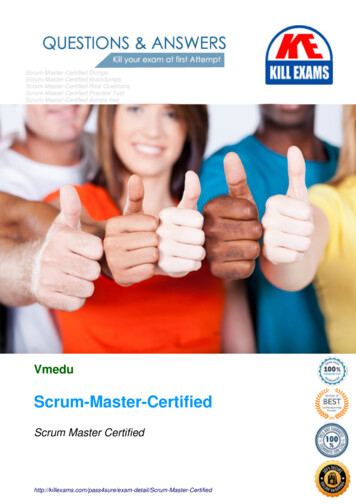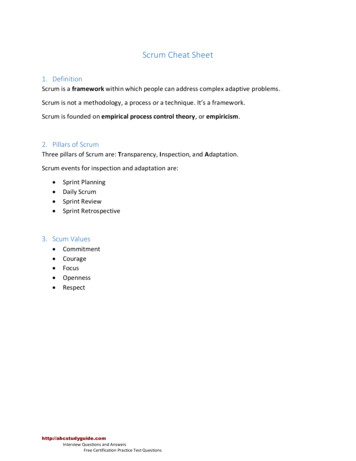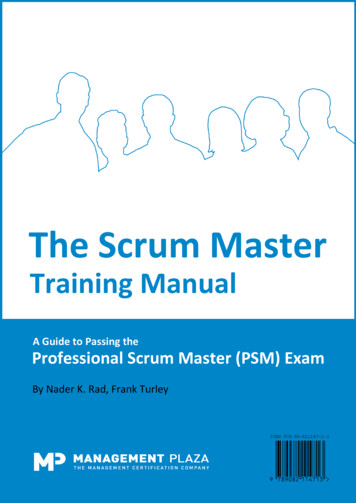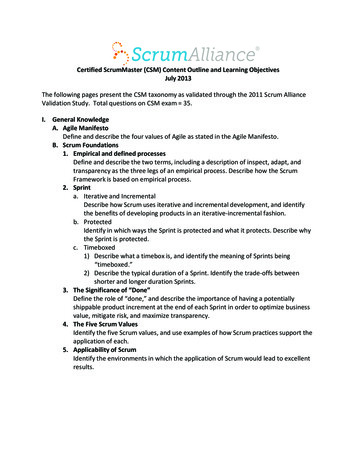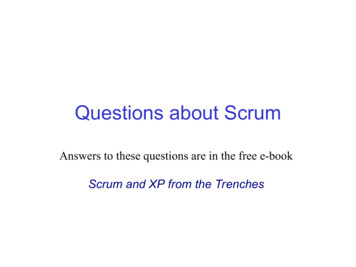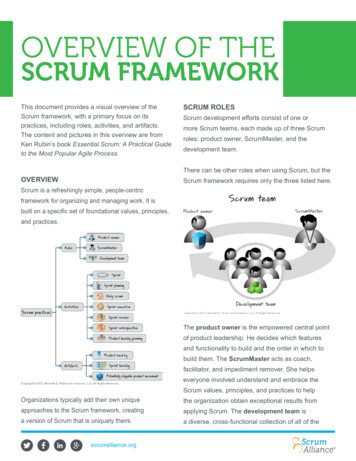
Transcription
OVERVIEW OF THESCRUM FRAMEWORKThis document provides a visual overview of theScrum framework, with a primary focus on itspractices, including roles, activities, and artifacts.The content and pictures in this overview are fromKen Rubin’s book Essential Scrum: A Practical Guideto the Most Popular Agile Process.SCRUM ROLESScrum development efforts consist of one ormore Scrum teams, each made up of three Scrumroles: product owner, ScrumMaster, and thedevelopment team.There can be other roles when using Scrum, but theOVERVIEWScrum framework requires only the three listed here.Scrum is a refreshingly simple, people-centricframework for organizing and managing work. It isbuilt on a specific set of foundational values, principles,and practices.The product owner is the empowered central pointof product leadership. He decides which featuresand functionality to build and the order in which tobuild them. The ScrumMaster acts as coach,facilitator, and impediment remover. She helpseveryone involved understand and embrace theScrum values, principles, and practices to helpOrganizations typically add their own uniquethe organization obtain exceptional results fromapproaches to the Scrum framework, creatingapplying Scrum. The development team isa version of Scrum that is uniquely theirs.a diverse, cross-functional collection of all of thescrumalliance.org
types of people needed to design, build, and test a desired product. The development team self-organizes todetermine the best way to accomplish the goal set out by the product owner. Development teams can be assmall as three people but are typically five to nine people in size.SCRUM ACTIVITIES AND ARTIFACTSThe figure below illustrates most of the Scrum activities and artifacts and how they fit together. Elements of thediagram are discussed in the sections that follow.SCRUM SUMMARYIn this picture, the blue items represent scope, green items represent tasks, and orange items represent process.Starting on the left side of the figure and working clockwise around the main looping arrow (the sprint), here isa summary of the Scrum framework.The product owner has a vision of what he wants to create (the blue cube). Because the cube can be large, throughan activity called grooming (also called refinement), it is broken down into a set of features (the blue bricks) that arecollected into a prioritized list called the product backlog.A sprint starts with sprint planning, encompasses the development work during the sprint (called sprint execution),and ends with the sprint review and sprint retrospective. The sprint is represented by the large, looping arrow thatdominates the foundation of the figure.scrumalliance.org
The number of items in the product backlog is likely toLet’s look at each element in a bit more detail.be more than a development team can complete ina short-duration sprint (of a few weeks). For that reason,PRODUCT BACKLOGat the beginning of each sprint, the development teamScrum teams try to always do the most valuable workmust determine a subset of the product backlog items itfirst. The prioritized list of this work is called a productbelieves it can complete — an activity called sprintbacklog. For new products, this backlog initially containsplanning, shown just to the right of the product backlog.those features required to meet the product owner’svision. For ongoing product development, the productTo acquire confidence that the development team hasbacklog might also contain new features, changemade a reasonable commitment, the team membersrequests, defects, and more.often create a second backlog during sprint planning,called the sprint backlog. The sprint backlog describes,through a set of detailed tasks, how the team plans todesign, build, integrate, and test the selected subsetof features from the product backlog during thatparticular sprint.Next is sprint execution, when the development teamperforms the tasks necessary to realize the selectedfeatures. Each day during sprint execution, the teammembers help manage the flow of work by conductinga synchronization, inspection, and adaptive planningactivity known as the Daily Scrum. At the end of sprintexecution, the team has produced a potentiallyshippable product increment that represents some,but not all, of the product owner’s vision.In the product backlog, some of the product backlogitems (blue bricks) are larger and others are smaller.The Scrum team completes the sprint by performing twoAnd some are lighter blue and others are darker blue.inspect-and-adapt activities. In the first, called the sprintLarger bricks are meant to represent larger pieces ofreview, the stakeholders and Scrum team inspect thefunctionality and the smaller bricks to mean smallproduct being built. In the second, called the sprintpieces. Lighter blue means lightly detailed and darkerretrospective, the Scrum team inspects the Scrumblue means more detailed. The product backlog itemsprocess being used to create the product. The outcomenear the top of the product backlog — the high-priorityof these activities might be adaptations that will makeitems — are smaller and darker blue, representingtheir way into the product backlog or be included as partproduct backlog items that are in a “ready” state. Theyof the team’s development process.are ready in the sense that they are sufficiently definedand well understood so that if the development teamscrumalliance.org
were to move them into a sprint during sprint planning,something of tangible value to the customer or user.the team members are reasonably confident they canSprints are timeboxed so they always have a fixedcomplete them by the end of the same sprint. Somestart and end date, and generally they should all beScrum teams formalize this idea by establishingof the same duration.a “definition of ready” — a set of criteria for determiningwhen a product backlog item is in the ready state.PRODUCT BACKLOG GROOMING(REFINEMENT)The product owner, with input from the stakeholdersand development team(s), is ultimately responsible formaintaining the product backlog, which evolves andchanges throughout the project. The activity of creatingA new sprint immediately follows the completion ofand refining the product backlog items, estimating them,the previous sprint. As a rule we do not permit anyrefining them, and prioritizing them is often known asgoal-altering changes in scope or personnel duringgrooming (also referred to as refinement). The producta sprint; however, business needs sometimes makeowner ultimately owns the grooming process; however,adherence to this rule impractical.members of the development team typically budget 5%to 10% of their total capacity each sprint to assist theSPRINT PLANNINGproduct owner with product backlog grooming.Every sprint begins with sprint planning. During sprintplanning, the team and product owner agree on a sprintgoal. The team then selects a subset of high-priorityready items from the product backlog that can becompleted during one sprint, assuming the team worksat a sustainable pace.SPRINTSIn Scrum, work is performed in iterations or cyclesTo acquire confidence in what it can get done, manycalled sprints, each lasting up to a calendar monthdevelopment teams break down each targeted feature(with the most common duration being two weeks).into a set of tasks (although they are not required to doThe work completed in each sprint should createso). The collection of these tasks (or any other artifacts),scrumalliance.org
along with their associated product backlog items, formsa second backlog called the sprint backlog.SPRINT EXECUTIONSprint execution is the period of time during whichthe development team, guided by the ScrumMaster’scoaching, performs all of the task-level worknecessary to get done the features agreed to duringsprint planning. In this context, “done” means thereis a high degree of confidence that all of the worknecessary for producing good-quality features hasbeen completed. During sprint execution, nobody tellsthe development team in what order or how to do thetask-level work in the sprint backlog. Instead, teammembers define their own task-level work and thenself-organize in any manner they feel is best forachieving the sprint goal.DAILY SCRUMEvery day of the sprint, the development team meetsfor a 15-minute inspect-and-adapt activity known as theDaily Scrum. An important goal of the Daily Scrum is tohelp a self-organizing team better manage the flow ofits work during sprint execution. A common approach forconducting a Daily Scrum meeting is for developmentteam members to share with each other what they didyesterday, what they are planning to do today, and anyobstacles they are facing. This meeting is frequentlyreferred to as a daily stand-up, because team membersare encouraged to stand to keep the meeting brief.scrumalliance.org
DONEIn Scrum, we refer to the completed work at the endof the sprint as a potentially shippable productincrement. Done, or potentially shippable, meanscompleted to a high degree of confidence and being ofsuch quality that the work could be shipped to endcustomers at the end of a sprint. Being potentiallyshippable, however, does not mean the results willactually be delivered to customers. Shipping isa business decision based on factors such as whetherthere is enough functionality, or whether our customerscan consume change at this rate; potentially shippablerefers to a state of confidence.SPRINT REVIEWThe sprint review occurs at the end of every sprintand is a time to inspect and adapt the product. Thesprint review is intended to foster conversation aboutthe just-completed functionality. Participants includethe product owner, ScrumMaster, development team,stakeholders, customers, and anyone else interested inthe outcome of the sprint. A successful review resultsin bidirectional information flow. The people who aren’ton the Scrum team get to sync up on the developmenteffort and help guide its direction. At the same time,the Scrum team members gain a deeper appreciationfor the business and marketing side of their product bygetting frequent feedback on the product’s success atdelighting customers or users.scrumalliance.org
SPRINT RETROSPECTIVEESSENTIAL SCRUM AND KEN RUBINThe sprint retrospective occurs at the end of every sprintThe content of this document is based on the bookand is a time to inspect and adapt the process. In theEssential Scrum: A Practical Guide to the Most Popularspirit of continuous improvement, the ScrumMaster,Agile Process, by Kenneth S. Rubin. The images inproduct owner, and development team come togetherthis document are part of the Visual AGILExicon to discuss what is and is not working with Scrum and(pronounced Visual Agile Lexicon), a freely availableassociated technical practices. The goal is to helpset of vibrant, four-color icons for composinga good Scrum team become great. At the end ofgraphically rich and visually appealing three-a sprint retrospective, the Scrum team should havedimensional representations of Agile and Scrumidentified and committed to a practical number ofconcepts. You can learn more about the Essentialprocess improvement actions that will be undertakenScrum book at www.essentialscrum.com and moreby the Scrum team in the next sprint.about the Visual AGILExicon atwww.innolution.com/resources/val-home-page.Ken Rubin is managing principal of Innolution, LLC(www.innolution.com), a company that provides Scrumand Agile training and coaching to help companiesdevelop products in an effective and economicallysensible way. A Certified Scrum Trainer , Ken hastrained over 24,000 people on Agile and Scrum,Smalltalk development, managing object-orientedprojects, and transition management. He hasCLOSINGcoached over 200 companies, ranging from start-upsAfter the sprint retrospective, the entire sprint cycleto Fortune 10 businesses. You can contact Ken atbegins again, starting with the next sprintkrubin@innolution.com or follow him onplanning session.twitter @krubinagile, on Facebook at:www.facebook.com/InnolutionLLC, and LinkedInat: www.linkedin.com/in/kennethrubin.view all of our industry articlesscrumalliance.org
Scrum framework, with a primary focus on its practices, including roles, activities, and artifacts. The content and pictures in this overview are from Ken Rubin’s book Essential Scrum: A Practical Guide to the Most Popular Agile Process. OVERVIEW Scrum is a refreshingly simple, people-centric framework for organizing and managing work. It is
